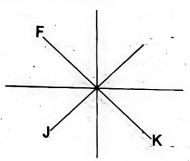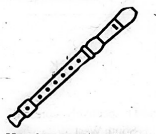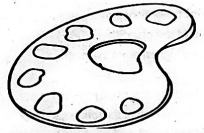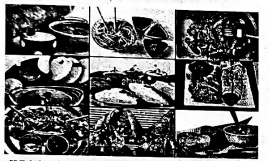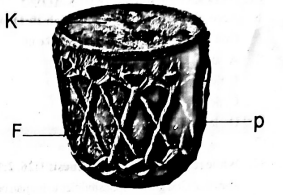SOCIAL STUDIES
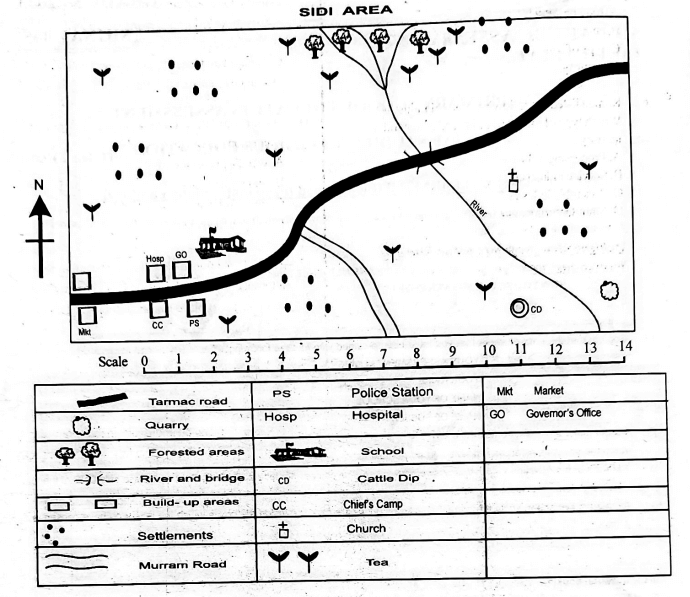
- The settlement pattern in Sidi area can be described as
- linear settlement
- dense settlement
- clustered settlement
- even settlement.
- The highest point in Sidi area is around the
- cattle dip
- shrubs
- forest
- chief's camp
- The flow of the river in Sidi area can be described as from
- North East to South
- North to South East
- South West to North
- North West to South East.
- The people in Sidi area are likely to be
- Hindus
- Muslims
- Pagans
- Christians.
- The location of the market in Sidi area was influenced by
- road passing by
- climate
- type of soil
- security.
- Kamau listed the following types of industries. Which type of industry is also called secondary industry?
- Processing industry
- Service industry
- Assembly industry
- Manufacturing industry.
Achieng drew the figure below. Use it to answer questions 7 to 8.
- The letters F and J respectively represent
- North East ans South West
- South West ans South East
- North West and South East
- North West and South West.
- Below are uses of the above figure. Which one is not? To
- show direction
- describe the flow of a river
- tell routes to a place
- show the highest point in a map.
- Grade 4 learners described physical features as shown below. Which of the following describes a plateau? A
- raised piece of land that is flat at the top
- form where water flows out of the ground from an underground source
- depression between two areas that are high or raised
- large lowland that is generally flat.
- Which one of the following is the main importance of the historic built environments?
- To attract tourist and earn foreign exchange.
- Provide employment opportunities.
- Remind and teach us about our culture.
- Create a sense of belonging.
- Which one of the following is a negative form of interaction? Through
- wedding ceremonies
- hunting activities
- raids and war
- religious activities.
- Henrick mentioned the following benefits of interdependence. Which one is not correct?
- People are able to live in harmony and unity.
- Promotes immorality.
- People get new ideas and knowledge.
- People are able to appreciate each other's culture.
- Belinda matched the industries in the county and their products. Which of the following is correctly matched?
Industry Product A. Creameries Cakes B. Pottery Cheese C. Jua kali Jikos D. Weaving Pots - A learner listed the benefits of trade in the county Which one is correct? It promotes
- bribery
- growth of slums
- pollution of the environment
- the agricultural sector.
- Below are economic activities in the county. Which one is the most common economic activity?
- Mining
- Saw milling
- Agriculture
- Basketry.
CREATIVE ARTS
- A teacher prompted learners to say any word that came in their minds. His aim was to give the words rhythmic names. Whose word was given the name ta-te?
- Lucy - Melon
- Janet-Gate
- Peris-Good morning
- Betty-Farm.
- Grade four learners discovered that a melody is composed by short and long sounds. Which of these is the shortest sound in Music?
- taa
- ta-te
- taa-aa
- taa-te-fe.
- Kiarie had four bottles. He wanted to produce sound with them. Which bottle produced the highest sound? The
- one half filled with water
- one fully filled by water
- empty plastic bottle
- empty metallic bottle.
- Musa sang a melody with these syllables:
mi fa so la. This is called _____________________ singing.- sideways
- upward
- downward.
- round.
- When we combine long and short sounds to form Music, we are creating
- pitch
- dynamics
- rhythm
- pace.
- Njue mentioned the elements of folk dance as shown below. Which one of them is false?
- Tempo
- Volume
- Space
- Energy.
- Participants were to carry musical instruments to accompany their folk songs performance. Who carried an instrument that is different from the others?
- Tom-whistle
- Steve-chivoti.
- Karen-coro
- Liz-isukuti
- Belinda decided to improvise the wind instrument shown below. 'Muturiru'
What is the best material for her to use?- Bamboo stick
- Wooden stick
- Plastic material
- Metal.
- Grade 4 learners were to sing the Kenyan National Anthem during assembly. On which day was it?
- Monday
- Tuesday
- Wednesday
- Thursday
- Grade 5 learners decided to take care of the instrument below.
How best can they do it?- Washing it while in use.
- Sharing with others who don't have.
- Keeping it under direct sunlight.
- Blowing it softly when using it.
A learner displayed the artwork below. Use it to answer questions 26 to 28.
- Which of the following types of lines is not used in the above artwork?
- Straight line
- Curved line
- Zigzag line
- Thick line.
- The learner decided to shade the artwork using the smudge technique. Which of the following materials is he not likely to use?
- Wax Crayons
- Coloured pencil
- Coloured Chalk
- Water colours.
- The above equipment is used to
- apply crayons
- make colours darker
- hold paint during painting
- make colours brighter.
Below is an artwork by a grade 5 learner. Use it to answer questions 29 to 31.
- Which of the following was not likely to have been used by the leaners to create the artwork above?
- Adhesive
- Pencil
- Needle
- Magazines.
- The above artwork was created using a technique called
- cutting and pasting
- collage
- montage
- sticking.
- When making the above artwork, one should consider the following factors except
- choose a particular theme
- ensure proper balance
- utilise the space well
- dry the artwork on a hot surface.
Grade 5 learners made the item below. Use it to answer questions 32 to 35.
- Which of the following materials is not used in making the above item?
- Nails
- Scissors
- Hammer
- Knife.
- The above artwork can be made using
- canvas
- leather
- nylon
- cotton fabric.
- Which of the following correctly matches the parts labeled F, K and P?
F K P A. Membrane
B. Laces
C. Laces
D. TinResonator
Membrane
Membrane
LacesLaces
Tin
Resonator
Membrane - The above item is played by
- tapping
- plucking
- blowing
- shaking
PART 2: Choose a section you have prepared for. Each section is 15 marks
CHRISTIAN RELIGIOUS EDUCATION
- According to the book of Jeremiah 29:11, what is God's purpose for our lives? To make us
- successful
- rich
- poor
- slaves.
- While reading the book of Genesis 1:26, 2:15, we learn that God gave responsibilities to human beings. Which of the following is not one of them? To
- name and take care of animals, fish and birds
- cultivate the land
- take care of the environment
- kill all the animals.
- Which of the following statements shows the way we can demonstrate good stewardship towards God's creation? By
- taking good care of the environment
- cutting down trees
- throwing garbage in the river
- killing wild animals.
- Learners wrote the following as factors that promote family unity. Which one does not promote unity?
- Sharing responsibilities at home.
- Reading the bible and praying together.
- Working together on chores and other projects.
- Arguing all the time.
- In Mathew 25: 14, we read about the parable of the talents. What lesson do we learn from it?
- God will punish us if we do not use our talents well.
- We should brag about our talents to others.
- We should laugh at those who do not have talents.
- We should not use our talents so that people do not know we have them.
- The Bible tells us about the fall of human beings. What lesson do we learn from it?
- We should obey God's word.
- We should not do anything we are told.
- God is merciless.
- The first humans were foolish.
- Which of the following is not a value we learn from the story of Noah and his sons?
- Honesty
- Empathy
- Obedience
- Carelessness.
- Grade 5 learners were discussing ways of showing respect to the elderly. Which of the following is not among them?
- Talking to them rudely.
- Helping with household chores.
- Obeying them.
- Offering them seats when there are no seats.
- We are taught that family unity is very important. This is because it
- promotes love and respect for one another
- brings chaos
- encourages theft
- brings about nepotism.
- Grade Spupils were learning about humility and pride. Which of the following is not a disadvantage of pride? It makes
- people selfish and self-centered
- a person feel superior and look down upon others
- a person succeed in life
- one be confident in themselves instead of in God.
- Wendy and her friends wrote the effects of child labour on a chart. Which one of the following is not one of the effect they wrote?
- Children become unhappy.
- Children become unhealthy.
- Children earn a lot of money.
- It affects the child's self-esteem.
- Grade 5 learners of were discussing the benefits of reading the Bible. Which of the following is not a benefit? Helps us to
- obey our elders
- know more about God
- know creation stories
- swear.
- Which of the following is not true about Peter and John? They
- told people about the Jesus who had risen from the dead
- healed a lame man in the name of Jesus Christ
- were arrested and put in jail
- earned a lot of money through healing people.
- Who among the following was not a member of the Jewish Council in which John and peter were brought in front of?
- Annas
- Jairus
- Alexander
- Caiaphas.
- Solving disputes is very important because it
- helps to maintain peace and harmony
- brings about pride
- helps one get rich quickly
- brings disagreements.
ISLAMIC RELIGIOUS EDUCATION
- Summar wrote the following prayers on a chart. Which one is NOT a sunnah prayer?
- Dhuha
- Asr
- Baadiya
- Qabliya.
- Grade five learners were asked to search for miracles of prophets on the Internet. Which one did they find out about Nabii Issa?
- Changed walking stick into a snake.
- Thrown into the fire but the fire did not burn him.
- Could understand the language of birds.
- Spoke at infancy.
- Two surahs known as muawidhatein are
- Naas and Maun
- Naas and Falaq
- Ikhlas and Naas
- Falaq and Fatiha.
- Saba'atul mathani must be recited in all prayers. Saba'atul mathani refers to
- Fatiha
- Falaq
- Fatih
- Baqara.
- The teacher narrated to grade 5 learners about the year of elephant. In the story, who wanted to destroy the Holy Kaaba?
- Abu jahal
- Abu Lahab
- Abraham
- Abraha
- In which surah is Ummu jamil mentioned?
- Maun
- Masad
- Ikhlas
- Tiyn.
- The prophet (saw) had the best character. Which one of the following was not among his characters?
- Untrustworthness
- Kindness
- Truthfulness
- Generosity.
- Grade 4 learners were discussing the manners of eating according to the sunnah of the prophet. Who gave the correct manners?
- Zubeir: Eating what is far from you
- Abdos: Eating hot-food.
- Kausy: Eating what is in front of you.
- Khubbayb: Eating with both hands.
- Complete the hadith on brushing our teeth. "Brushing of teeth is a means of purification of the mouths and pleasing
- Allah
- Angels
- parents
- iblis.
- Which one of the following pillars of Islam does not require physical fitness?
- Swalah
- Jum
- Zakat
- Hajj.
- Allah SWT sees everything. Which attribute of Allah describes Him as the all-seeing?
- AL samiu
- AL basir
- As salaam
- AL malik.
- Angels of Allah are created from
- nur
- clay
- fire
- smoke.
- Grade 5 learners were asked to write down the angels mentioned in the Holy Qur'an. How many prophets did they write down?
- 35.
- 15
- 20
- 25
- Angels have special duties. Which angel is incharge of rain?
- Mikail
- Malik
- Israfeel
- Raqib
- Who among the following prophets is referred to as ulul azm?
- Yunus
- Yusuf
- Yahya
- Musa.
MARKING SCHEME
- C
- C
- B
- D
- A
- C
- D
- D
- A
- A
- C
- B
- C
- D
- C
- A
- B
- D
- B
- C
- B
- D
- A
- A
- D
- A
- D
- C
- C
- A
- D
- A
- B
- C
- A
CRE
- A
- D
- A
- D
- A
- A
- D
- A
- A
- C
- C
- D
- D
- B
- A
IRE
- C
- D
- B
- A
- D
- B
- A
- C
- A
- C
- B
- A
- D
- A
- D
Download Creative Arts, Social Studies & Religious Education Questions and Answers - Grade 5 Mid Term 2 Exam 2023 Set 2.
Tap Here to Download for 30/-
Get on WhatsApp for 30/-
Why download?
- ✔ To read offline at any time.
- ✔ To Print at your convenience
- ✔ Share Easily with Friends / Students

